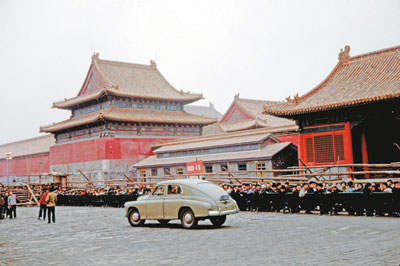|

Cao Zhen
caozhen0806@126.com
“AFTER History: Alexandre Kojeve as a Photographer,” a research-based exhibition at OCT Contemporary Art Terminal (OCAT), unveils the unique photography of Russian-born French philosopher and diplomat Alexandre Kojeve (1902-1968).
The exhibition includes nearly 400 photographs taken in the 1950s and 1960s during Kojeve’s extensive travels in Sri Lanka, China, India, Iran, Japan, Nepal, the Soviet Union, and throughout Western Europe. His journey and lifetime collection of postcards are also on display to capture the essence of both his philosophy and politics.
Kojeve thought history ended with the French Revolution, as it had achieved particular individual freedoms and the universal recognition of human rights. This notion of the “end of history” was later famously used by political scientist Francis Fukuyama to explain the loss of ideological antagonisms after the fall of the Berlin Wall in 1989.
Believing that under the post-historical condition one should stop thinking about the world and instead try to change it, Kojeve abandoned philosophy to work for the French Ministry of Economic Affairs. Remarkably, after this shift from deliberation to action Kojeve started to develop his own obsessive photographic practice in order to chronicle the post-historical world.
According to German art critic and philosopher Boris Groys, curator of the exhibition, Kojeve took more than 5,000 photos and collected thousands of postcards which are housed in his archive in the Bibliotheque Nationale de France in Paris.
The exhibits are not the real photos and postcards but presented in 11 projectors or as duplicates. “The collection of both photographs and postcards portrays the world as Kojeve articulated it through his philosophical thinking: an aesthetically harmonious and exotic East; a stiflingly complete and hollow West; and Russia, Kojeve’s rapidly changing homeland, is shown mainly through old churches frozen in time,” said Gwen Parry, project coordinator of BAK in the Netherlands.
Before reaching OCAT, this exhibition was initially on display at BAK, basis voor actuele kunst in Utrecht, the Netherlands between May and July and presented as part of the Nineth Gwangju Biennale in South Korea in early September.
Dates: Until Nov. 16
Hours: 10 a.m.-5:30 p.m.
Venue: OCT Contemporary Art Terminal, Enping Road, Overseas Chinese Town, Nanshan District (南山区华侨城恩平路当代艺术中心)
Metro: Qiaocheng East Station (侨城东站), Exit A
|

